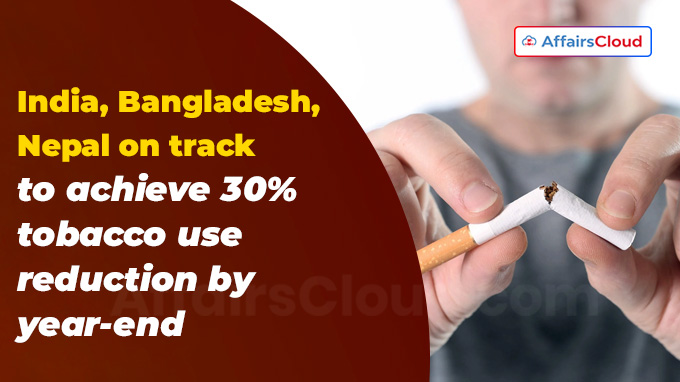In October 2025, the World Health Organisation (WHO) released the 6th edition of ‘WHO Global Report on Trends in Prevalence of Tobacco Use 2000-2024 and Projections 2025-30’. As per the report, 3 South-East (SE) Asian countries: Bangladesh, India and Nepal are on track to achieve at least 30% relative reduction in tobacco use by the end of 2025.
While, 6 other SE Asian countries: Bhutan, Democratic People’s Republic (DPR) of Korea, Maldives, Myanmar, Sri Lanka and Thailand, are projected to witness smaller declines in tobacco use.
This milestone is part of the WHO’s global target to reduce tobacco use among individuals aged 15 and above by 30% between 2010 and 2025, as outlined in the WHO Global Action Plan for the Prevention and Control of Noncommunicable Diseases(NCDs).
Exam Hints:
- What? Release of WHO Report
- Report Name: ‘WHO Global Report on Trends in Prevalence of Tobacco Use 2000-2024 and Projections 2025-30’
- Edition: 6th
- Released by: WHO
- Global Decline in Tobacco Users: from 1.38 billion (in 2000) to 1.2 billion (in 2024).
- Global Decline Rate of Tobacco Use: by 120 million users (-27%) between 2010 and 2025
- Tobacco Consumption Rate: Women (6.6%) and Men (32.5%)
- E-Cigarettes User: Over 100 million
- Fastest Decline: SEAR with 69 million fewer users (in 2024)
- Region-wise tobacco use: Lowest (Africa at 9.5%); highest (24.1%); slowest progress(Western Pacific at 22.9%); highest among men (Western Pacific at 43.3%)
About WHO Report:
Overview: This latest report presents WHO estimates of tobacco use prevalence among people aged 15 years and above from 2000 to 2024, with trends projected to 2030.
The report presents the estimates at global, regional, and country levels.
Source: The key findings of the WHO latest report are based on 2,034 national surveys, which cover 97% of the world’s population.
Key Target: The Sustainable Development Goal (SDG) Target 3.a and the WHO NCD Global Action Plan, which aimed to achieve 30% relative reduction in tobacco use by 2025.
Current Status: At present, only 27% global reduction in tobacco use has been achieved, falling short by 50 million users
Global Scenario:
Tobacco Use: The WHO report shows global tobacco users declined from 1.38 billion in 2000 to 1.2 billion in 2024, and is projected to drop by 120 million more by 2025, a 27% relative reduction.
E-Cigarettes & Vape: For the 1st time, WHO has presented estimates of global e-cigarettes use. As per the report, over 100 million people worldwide now use e-cigarettes, of which nearly 86 million are adults, who live in High Income Countries (HICs).
- The report also highlighted that prevalence of e-cigarettes or vape is also common among teenagers, at least 15 million teenagers aged between 13 and 15 years, are already using e-cigarettes.
- The report further projected that children are on average 9 times more likely than adults to vape.
Gender Trends: The WHO report highlights a steady decline in tobacco use among all age groups from 2000 to 2024, with women leading in quitting.
- Women reached the 30% global reduction target by 2020, five years ahead of schedule, with tobacco use falling from 11% (2010) to 6.6% (2024) and female users dropping from 277 million to 206 million.
- In contrast, men who make up over 80% of global tobacco users are not expected to meet the target until 2031, with around 1 billion male users still consuming tobacco.
- The report also revealed that prevalence of tobacco use among men has declined from 41.4% (in 2010) to 32.5% (in 2024).
Key Progress Made by WHO SEAR:
Regional Progress: The report highlighted that WHO South-East Asia Region (SEAR) has made the fastest progress worldwide in reducing tobacco use.
As per the report, WHO-SEAR is projected to account over 50% of global reduction (120 million users), with 69 million fewer tobacco users.
Decline of tobacco use: The report underscored that one the world’s hotspot for tobacco use, the region reported the world’s highest tobacco use prevalence among men (70.1%) and women (38%) in 2000.
The report highlighted that prevalence among men halved to 37% and 9.3% among women in 2024.
Remaining Challenge: Despite rapid declines, the SEA Region still has over 322 million adult and 8.6 million adolescent tobacco users, including 288 million smokeless tobacco users, accounting for 25% of the world’s total.
E-Cigarettes Users: The report showed that there are estimated 1.8 million adult and 5 lakh adolescent e-cigarette users in SEAR.
Rate of Tobacco Use : The report projected rates of tobacco consumption for countries like: India, Nepal, and Sri Lanka at 21.9%, 28% and 20.4%, respectively.
Key Findings for Other Regions:
Africa: Tobacco prevalence in Africa is the lowest globally at 9.5% in 2024 and on track for the 30% reduction target, but the absolute number of users is rising due to population growth.
Europe: Europe has the highest overall adult tobacco prevalence at 24.1% in 2024, with women leading globally at 17.4%.
Eastern Mediterranean: The prevalence of tobacco use in this region stood at 18% (in 2024), with continuous rise in tobacco use in some countries.
Western Pacific: Tobacco use in the Western Pacific declined slowly from 25.8% (2010) to 22.9% (2024). Men (43.3%) and women (2.5%) in the region show the highest gender disparity globally.
About World Health Organisation (WHO):
Director General (DG)- Dr. Tedros Adhanom Ghebreyesus
Headquarters- Geneva, Switzerland
Established – 1948





